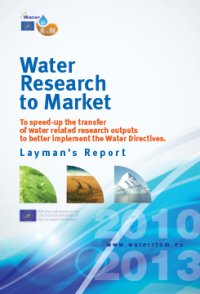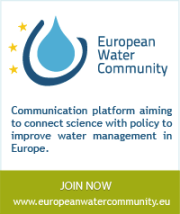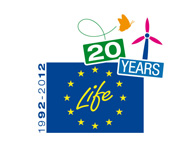AGUAFLASH
| Output characterisation | |
| OUTPUT SENTENCE | Determine the risks of deterioration of water quality in agricultural catchments |
| OUTPUT TYPE | DSS |
| WATER TOPIC | Quality of natural systems |
| KEYWORDS | River, water pollution, agricultural catchments, flood events, water quality deterioration |
| KEYWORDS TYPE | DSS |
| MARKET NEED TAILORED | Cross-compliance of Water Framework Directive and of the Common Agriculture Policy ; protection of drinking water supply zones In agricultural catchments, in situ bodies of water used for drinking water supply are subjected to contamination risks during flood events, with the contamination level of the water flooding. The relevant authorities tasked with dealing with water contamination risks have to meet two different challenges: • How to best manage drinking water catchments located in these risk areas. • How to determine the biological results of these risks on drinking water and on aquatic ecosystems. This must include considering the ‘invisible’ risks notion linked to the very selective characteristics of floods, which can evade the usual survey system. |
| OUTPUT DESCRIPTION | The AguaFlash is a method to determine the risks of deterioration of waters quality in agricultural catchments including floods events, transposable to the southwestern part of the European territory (France, Spain, Portugal). This project aims to mathematically define these relationships and to make them available in a tool for identification and characterization of the production zones of pollutants, particularly pesticides, in periods of flooding. |
| STATE OF DEVELOPMENT | A prototype will be delivered on march 2012. This prototype will allow to evaluate the risks of water quality deterioration including flood periods in agricultural catchments in the south western Europe area. |
| INNOVATIVE ASPECTS AND ADVANTAGES | The chemical and physical quality of the water in rivers and groundwaters is characterized by indicators, which take into account the average level of pollution. Recent works show that even if the average physico-chemical quality of water stays below the contamination threshold, biological impacts are measurable (for example, constant degradation of the biological indicators). For example, contamination by pesticides is very difficult to detect because the average concentrations are often below the analytical detection thresholds during stable hydrological periods. However, their main impact on the biological and health quality of waters is probably linked to chronic events (bioaccumulation processes) and high toxicity processes during flood events. Moreover, it is impossible at the moment to establish a direct relationship between floods and water quality deterioration. Several processes occur during flood events (topography, hydromorphology, remobilisation of sediments and pollutants linked to them). This project aims to mathematically define these relationships and to make them available in a tool for identification and characterization of the production zones of pollutants, particularly pesticides, in periods of flooding. |
| INTELLECTUAL/INDUSTRIAL PROPERTY RIGHTS | The different parts of the Prototype are property of the partner of the project which has developed it. |
| TRANSFERABILITY | The portability will be tested 1/ at the same scale than the experimental basin and 2/ at larger scale. |
| BUSINNESS CASE | Yes |
| Estimation of risks | |
| EVALUATION OF RISKS FOR OUTPUT USERS | This software will be a tool to help decision-makers in the management of drinking water catchments areas in order to prevent the risks of water pollution in periods of flooding. |
| TECHNICAL RISKS | Absence of risk on legal aspects. High risk level for market aspects * |
| Steps ahead | |
| NEXT STEPS TO ACHIEVE THE STATUS 'READY TO USE' | feasibility study to go on the market – 4 steps STEP 1 : Demonstration of the transferability of the prototype STEP 2 : Market Analysis STEP 3 : Intellectual Property STEP 4 : Development of a software |
| TYPE OF PARTNER FOR THE NEXT DEVELOPMENTS | The feasibility study will be run with the scientific partners of AGUAFLASH for STEP 1 and with software developers for STEP 4. |
| TASKS TO BE PERFORMED | development of user friendly interface with feasibility study |
| COLLABORATION DETAILS | This project regroups six teams of research French, Spanish and Portuguese : - CNRS, charged of the coordination of the project (France), - University of the Basque country (Spain), - Agencia Estatal of Investigacion CSIC (Spain), - Cemagref (France), |
| Estimation of ressources | |
| RESOURCES FOR NEXT STEPS | The estimated cost of the feasibility study is of 1 Meuros. |
| FORESEEN COSTS FOR NEXT STEPS | 700 000 euros |
| Contact | |
| TECHNICAL CONTACT | Name : José Miguel SANCHEZ PEREZ *Address : ECOLAB, ENSAT, Avenue de l'Agrobiopole, BP 32607, 31326 CASTANET TOLOSAN Cedex, FRANCE *Phone : + 33 5 34 32 39 20 * Fax : +33 5 34 32 39 01 *Email/s e-mail: sanchez@cict.fr *Website : http://www.aguaflash-sudoe |
| COUNTRY | FRANCE |
| WATER RTOM CONTACT | OIEau |
| Background | |
| PROJECT ACRONYM | AGUAFLASH |
| PROJECT DESCRIPTION | The AguaFlash is a method to determine the risks of deterioration of waters quality in agricultural catchments including floods events, transposable to the southwestern part of the European territory (France, Spain, Portugal). This project aims to mathematically define these relationships and to make them available in a tool for identification and characterization of the production zones of pollutants, particularly pesticides, in periods of flooding. |
| LEADER | Research institution CNRS (or ENSAT?) |
| COUNTRIES INVOLVED | FRANCE, SPAIN, PORTUGAL |
| PROJECT LOCATION | EU |
| FUNDING ORGANISATION | Interreg IV SudOuest |




